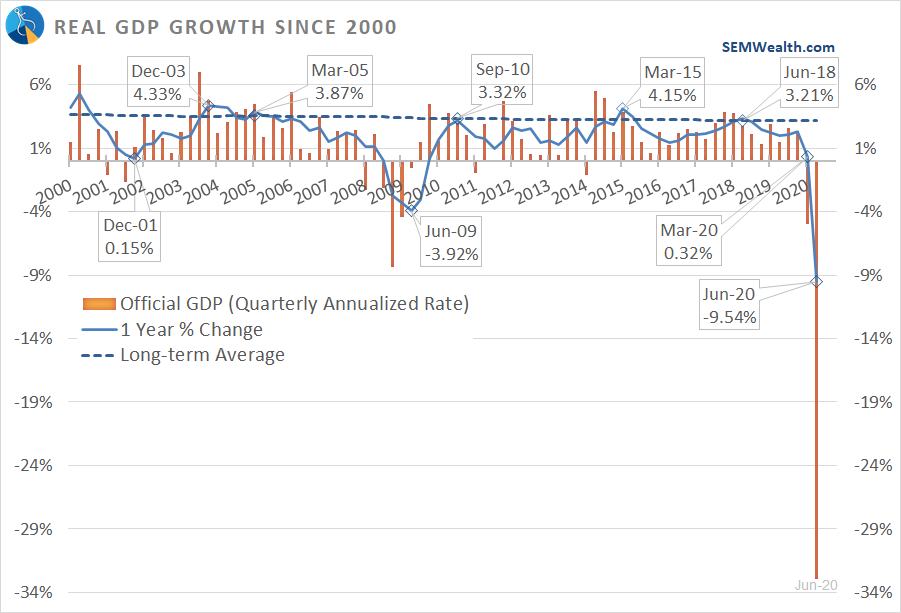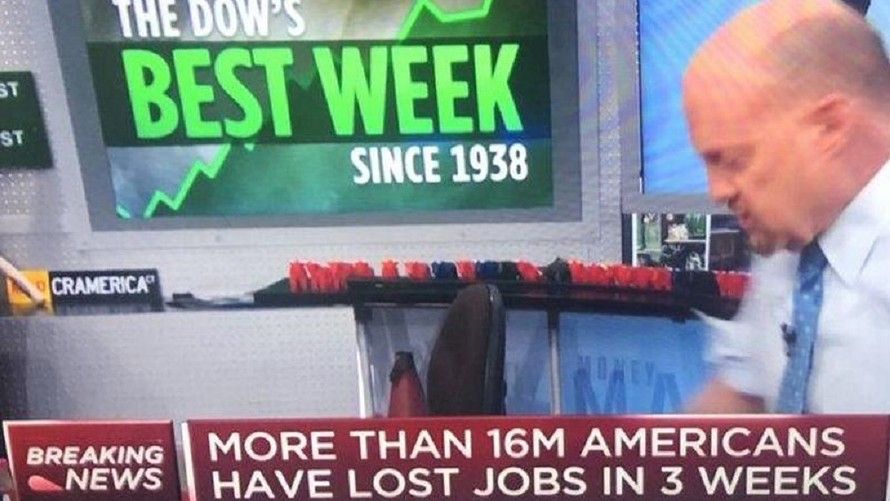Each week is different, but yet every week seems the same. We get some good news on the economy, some really bad numbers, some good earnings reports, some bad earnings reports, some sort of news item from the Fed, talk of more stimulus, delays of those talks, and of course all kinds of thoughts from the President.
In this week's musings, we talk about the scary economic numbers, why it's not as bad as it seems, look at some good news on the virus, and what we've learned from the re-opening of professional sports.
We didn't lose 1/3 of the economy
The big news last week was the "33%" drop in the economy during the quarter. This is the perfect example of why I hate the way the government reports the numbers. So many people misunderstood what the number actually meant. I posted a quick blog after the headlines hit. If you missed it, I'd encourage you to take a look.

Refreshingly, some "liberal" news sources, including the New York Times and The Washington Post did not sensationalize the headlines and instead focused on how GDP is calculated. The Post had some great charts illustrating the actual economic impact.

In the first quarter the economy shrunk by $6 billion. In the second quarter it contracted by $450 billion.
To put it in perspective, the Post also compared this recession to past recessions. You can see this is the fast drop in our economy on record, but the massive stimulus and actions by the Fed means it should not continue down the path of the 1929-1937 or 1945-1948 recessions.

Still a long way to go
While the depth of the recession should not get as severe as the Great Depression, we should not assume we will quickly get back to "normal". Congress has already authorized $3.7 Trillion in stimulus, but only about $1.5 Trillion of it has been spent (source). Congress is already debating another round of stimulus that could range from $1-3 Trillion. From February to June, the US borrowed $3 Trillion (source), which is a 13% jump in Government Debt. To put that number in perspective, in 1990 the TOTAL National Debt was $3 Trillion (source). This led Fitch to downgrade the outlook for US Debt Friday afternoon to 'negative' although they are retaining the 'AAA' rating.
[Side note: Only S&P has stripped the US of its top rating, something they did back in 2011. If one more ratings agency downgrades US Debt, there would be major ramifications as tens of trillions of dollars in institutional, government, insurance, and pension funds have specific obligations to hold a certain percentage of 'AAA' debt.]
Consumer spending has certainly been helped by the $1.5 Trillion, but it is still lagging the peak levels.

To put that number in perspective, spending is the same as it was in February 2018.
Last week we saw jobless claims increase once again. During an economic expansion and the subsequent recovery, jobless claims has a tight correlation to the stock market.
For more on this indicator, check out this article:

Adding to the longer-term risk is the upcoming election and the on-going social unrest, which could continue to cause volatility and big changes in our economy. And then of course we have the virus.
The on-going virus experiment
From the outset in February I've cautioned about jumping to conclusions. Our country has never faced a pandemic quite like this one. Hindsight bias will be prevalent. With all the information we have now, we are questioning the actions of our leaders from months earlier. Grace, prayers, and patience for all of our government leaders is important.
Last week I posted an encouraging and highly educational video from one of our Cornerstone Model partners, Eventide Funds. The Chief Investment Officer is both an MD and a PhD (in chemistry and chemical biology). He's been a great source of information throughout the pandemic. I'd encourage you to take some time to watch the presentation.

Deaths per day have again crossed 1000, but it is significantly lower than what we saw at the worst part of the crisis. The presentation above talks about all the ways doctors have improved their treatment of patients, cutting down on the mortality by a large margin. Even with that, we still have a large number of people dying each day.

Across the country the percent positive tests has remained relatively stable, which in my opinion is good news. Ignore the sensationalized headlines about the 'record' number of cases and focus on this number (source).

This doesn't mean specific sections of the country are not at risk, but overall the US is not as bad as it seems.
A slam dunk and a strike out
I've been marking the weeks since the Pandemic started since the country started noticing. This was back on March 11 when the NBA suspended their season in a couple of hours after several players tested positive for COVID19. Within a few days all major sports leagues suspended their seasons. With the re-opening of the NBA and NHL last week, every sport has now resumed.
We now have some more data points in this ongoing experiment. The NBA and NHL (along with Major League Soccer and the WNBA) have chosen to put their teams in a "bubble". There are strict testing and quarantine requirements if somebody leaves the bubble. The benches are distanced. In the NBA players have assigned seats with staff all wearing masks. Since the quarantine period ended, neither league has had a single positive test.
Watching the games without fans was strange, but with the electronic crowd noise, music, and other technological enhancements, there were times over the weekend where you forget there aren't any fans in the stands.
Then we have Major League Baseball. Despite being a socially distanced sport to begin with, the players and owners argued about formats and compensation for months. The thought of a "bubble" was immediately shot down. They ended up only having a week of being the only professional sport on television. It also only took a week for a team to have a major outbreak. The Miami Marlins now have 18 of their 30 traveling players with positive COVID19 tests. By all accounts, the team was very lax in their enforcement of the league's standards, frequently going out to restaurants and other places with some not wearing masks. The virus has quickly spread through their clubhouse.
The St. Louis Cardinals also have had an outbreak, but for now it seems this was the result of the players all catching it from the same person outside the organization. MLB is imposing more strict controls on the players to prevent more outbreaks, but without a "bubble" it seems likely more players will contract the disease.
This of course comes as the decision to re-open schools is at the forefront. To truly get the economy back to full strength we need schools to be open. When/how that happens is a difficult decision. Again, grace, prayers, and patience for our leaders. I'm glad I don't have to make these calls.
Why not throw in a hurricane?
Leave it to 2020 to have a more active than normal hurricane season. Here in Virginia we are tracking the earliest "I" named storm (Isaias) on record (source). It looks like it will cross us as a Tropical Storm sometime early Tuesday morning. As a reminder, we have full disaster recovery plans and will have them in place Monday evening. Our house has a basement, a whole house generator, and back-up internet service. We also have our Tucson office, which other than the risk of melting from the excessive heat is a low weather risk back-up site if needed.
Unless things change this will be our third direct hit since we moved to Virginia three years ago. The coronavirus actually has us better prepared than ever with weeks worth of food and supplies on hand.
[Update: We were startled awake at 4:30 am on Tuesday by a Tornado Warning. One had touched down about 15 miles from our house. We had several more warnings through 6:30 am. We lost power briefly and had several flickers throughout the morning, but kept our power. Others were not so lucky. The rainfall totals were estimated at 5" in our area with very little wind damage. Until the next one........]





